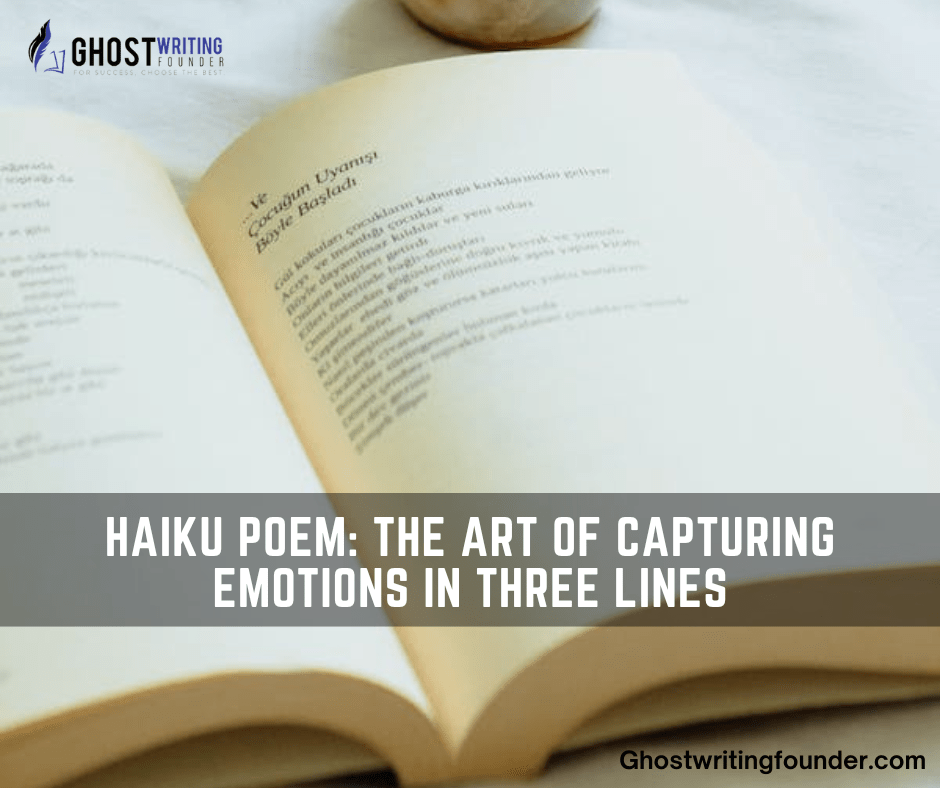
Writing
The Origins of Haiku Poetry
The roots of Haiku poems can be traced back to ancient Japan, where they emerged as a response to the elaborate and often lengthy poetry forms of the time. For more on the evolution of poetic forms, see Exploring the Depths of Literary Fiction A Guide to the Best Works.
Haiku’s simplicity and focus on nature allowed poets to distill powerful emotions and vivid imagery into a few carefully chosen words, much like the concise yet profound Short Poems About Life and Struggles.
Originally known as “hokku,” Haiku was prominent during the Edo period (17th to 19th centuries) and later became a standalone art form.
The Meaning of Haiku Poems
Haiku is a three-lined form of classical Japanese poetry. It usually has 17 syllables in the sequence 5-7-5.
Typically, haikus capture a single vivid image or profound feeling related to nature, the seasons, or a fleeting moment.
The Nonfiction book writer goals are to make the audience feel something, think, and feel present. Short and sweet, with an emphasis on using oblique language to convey deep thoughts, haikus are a Japanese form of poetry.
Mastering Emotion and Imagery
The heart of the Haiku poem lies in its ability to evoke emotions and create vivid imagery within a confined space. Poets masterfully weave together words that resonate deeply with readers, transporting them to a specific moment.
Through carefully selected imagery, Haiku captures the essence of nature, human experiences, and emotions, painting a rich tapestry of sensations.
Crafting Haiku: The Artistry
Creating a compelling Haiku is akin to crafting a masterpiece. Every word must serve a purpose, and the interplay of language, rhythm, and meaning requires meticulous attention.
The poet must distill their thoughts to the core, eliminating extraneous elements, a process well-articulated in the blog on Crafting a Book A Step-by-Step Guide for 2023. This discipline cultivates a heightened awareness of language and allows for a profound connection between the poet and the reader.
The Role of Syllables
Syllables are the building blocks of Haiku, and their arrangement is critical to its impact. The 5-7-5 structure forces poets to make deliberate choices, leading to a harmonious flow of words, a discipline that can be further refined with the help of Children’s Book Editor services.
However, modern Haiku poets often experiment with syllable counts, deviating from the traditional form while preserving the essence of brevity and depth.
Haiku as a Reflection of Life
Haiku’s fascination with nature reflects the delicate balance between human existence and the world around us. It captures fleeting moments, reminding us of the impermanence of life.
Haiku poets find inspiration in the changing seasons, the beauty of landscapes, and the intricacies of human relationships. Each Haiku is a mirror that reflects the ever-shifting tapestry of existence.
The Haiku Community
Haiku has transcended geographical boundaries in the digital age, fostering a global community of poets and enthusiasts, much like the expansive reach of Content Creation Services. Online platforms allow poets to share their creations, receive feedback, and connect with like-minded individuals, similar to the community-building aspects discussed in Pinterest for Bloggers: How to Use Pinterest for Blogging.
This sense of camaraderie and collaboration enriches the Haiku experience, pushing the boundaries of creativity and innovation.
The Enduring Charm of Haiku
Haiku’s ongoing popularity stems from the emotional depth to which the poems may connect with their readers. Its shortness begs for thought, prompting readers to delve deeply into their experiences and emotions, akin to the reflective nature of Sad Poems About Love.
In a world where information is constantly thrown at us, Haiku can be a welcome respite, allowing us to slow down and connect.
Haiku Form and Function
A haiku’s three-line, seventeen-syllable structure belies its apparent complexity. However, its appearance belies a great complexity beneath the surface. Three lines make up a classic haiku, with 5, 7, and 5 syllable counts.
This restriction pushes Poets to their creative limits, forcing them to pack every word they use with significance.
4 Features of Haiku Poetry
The traditional concentration of haiku poetry is on nature themes and imagery that evoke a specific season. Frequent in Haiku is the juxtaposition of two images. Here are some additional characteristics of haiku poem writing:
Kigo: Traditional Haiku contain a kigo, a season-specific word or phrase. The Haiku’s frugality is because each season is indicated with a single word. The most traditional kigo are sakura (cherry blossoms) for spring, fuji (wisteria) for summer, tsuki (moon) for autumn, and sushi (chill) for winter.
Kireji: Known in English as the “cutting word,” kireji generates a pause or break in the poem’s rhythm. Frequently, the kireji juxtaposes two images. Modern Haiku may only sometimes include a kireji, but the juxtaposition is still typical.
Nature and the Seasons: The original purpose of Haiku was to describe the season, and poets continue to concentrate on the natural world and how it changes throughout the year.
A Japanese haiku includes seventeen or more syllables. Because on are counted differently than English syllables, translators cannot agree on whether seventeen English syllables convey the spirit of Haiku.
A Brief Overview of Haiku
Originating in Japan, Haiku has a lengthy and illustrious history.
- Renga was a prominent Japanese poetic form in the thirteenth and fourteenth centuries. Renga is a longer collaborative poem composed of alternating lines penned by two or more poets. Renga was governed by a codified structure and intricate principles and was composed formally over several hours. Renga began with a brief verse known as hokku, establishing the mood and setting the poetry in a particular season. This opening verse, frequently composed of three short phrases containing five, seven, and five sounds, is the progenitor of contemporary Haiku.
- Masters of Haiku: Poets of the sixteenth century began experimenting with composing hokku without the renga. During the Edo Period (1603–1867), a reformist poet named Matsuo Basho (1644–1694) created and popularised a form of renga called haikai that was more casual and humorous. Bash and the reformist poets Yosa Buson (1716–1784) and Kobayashi Issa (1716–1824), who possessed a greater capacity for expression and tonal variation, found humor in describing mundane objects.
Meiji Era (1868–1912)
During the Meiji Era (1868–1912), poets such as Masaoka Shiki (1868–1902) popularised the hokku even further. In the nineteenth century, hokku was renamed Haiku and became a completely autonomous form of poetry.
- In the nineteenth century, Haiku spread outside Japan, first to the Netherlands and France and then North America. Imagists such as Ezra Pound (1885–1972) regarded the Haiku as a significant influence.
- Even though it does not adhere to the traditional five-seven-five-line structure, “In a Station of the Metro” (1913) by Ezra Pounds is an early American haiku. Observe how Pound juxtaposes two vibrant images in this passage: “The apparition of these faces in the crowd: petals on a wet, black bough.” In the 1950s, Beat poets also drew inspiration from Eastern philosophy and Haiku. Haiku (1951) by R. H. Blyth introduced English-speaking readers to the art by providing translations of Japanese Haiku.
How Time Capsule Haiku Can Preserve Recollections and Feelings
How a time capsule haiku poem preserve memories and emotions originally and artistically? It enables people to capture the substance of a moment or emotion concisely and enduringly, making it a unique memento for future generations to cherish.
Additionally, time capsule haiku provides a forum for individuals to reflect on their experiences and emotions, enabling them to comprehend better and value past events’ significance.
A Selection of Time Capsule Haiku from Various Eras
A Variety of Time Capsules “Haiku from Different Time Periods” refers to a collection of haiku compositions composed and preserved at various times. These poems serve as a time capsule, capturing the author’s feelings, emotions, and experiences at a particular period.
The Haiku chosen for this section should demonstrate the variety of themes and points of view and the evolution of Haiku over time.
The purpose is to provide a glimpse into the past by emphasizing immutable, still-relevant universal themes and emotions. The analysis and interpretation of Haiku can illuminate the era’s cultural, social, and historical context and the author’s personal experiences. The Haiku’s themes and messages can stimulate discussion and contemplation, prompting readers to consider their experiences and memories.
Interpretation and Analysis of the Haiku
This section will analyze the meaning and message of a selection of time capsule haikus in greater detail. This may involve examining the Haiku’s language, imagery, and cultural and historical context. This section aims to give readers a deeper understanding of the time capsule haiku and inspire them to think more critically about the themes and emotions they elicit.
Analysis of the Haiku’s Themes and Messages
This section may examine common themes and messages found in time capsule haiku, such as capturing the essence of a specific moment or place in time, conveying gratitude, or reflecting on the passage of time and the changing seasons. The discussion could also focus on each Haiku’s unique perspectives and emotions and how they relate to larger cultural and historical contexts.
What Are Some Basic Haiku Facts?
Here are some facts about Haiku, the words they contain, and the thought process behind them to help you acquire a more profound understanding:
- Tanka is an extended type of poetry composed of five lines with the syllable structure 5-7-5-7-7. In comparison to Haiku, it permits more narrative and expressive elements.
- Seasonal Words (Kigo): Traditional Haiku frequently include kigo, or seasonal words, to denote the season and establish a connection with nature. These words help invoke a particular season or period.
- The kireji is a word or phrase used in Haiku to create a pause or shift in the poem, often dividing it into two distinct sections. It highlights and improves the poetic structure.
- Using juxtaposition, Haiku frequently contrasts two distinct elements or concepts within a poem. This technique provides the reader with a moment of astonishment or insight.
Nature and Zen Aesthetics
Haiku is inspired by nature and frequently reflects the influence of Zen Buddhism. It focuses on simplicity, clarity, and the appreciation of fleeting natural moments.
- Throughout history, numerous poets have attained proficiency in the haiku art form. Matsuo Basho, Yosa Buson, and Kobayashi Isao are well-known Japanese haiku masters. Their works have significantly impacted the evolution and comprehension of Haiku.
- Poets have written haiku poems in languages other than Japanese, such as English, Spanish, and French, as the haiku form has become popular internationally. Each language has its own distinctive characteristics and cultural nuances.
- Numerous haiku contests, literary journals, and the Ghostwriting Founder devoted to publishing Haiku. These platforms allow established and emergent poets to share their work and interact with the haiku community.
- There is an ongoing exploration of new styles, techniques, and subject matter in contemporary Haiku. Poets who compose Haiku frequently experiment with form, eschewing traditional syllable counts and focusing more on conveying the essence of a moment or emotion.
How to Compose a Time Capsule Haiku?
- Choose a theme for the Haiku for the time capsule: Consider the capsule’s purpose and the message or emotion you wish to convey.
- Consider the experiences, emotions, and occurrences you wish to convey in your Haiku. Consider nature, personal memories, and current events as sources of inspiration.
- Examine the form of Haiku: The first line of a haiku has five syllables, the second line has seven syllables, and the third line has five syllables. Comprehending this structure when composing a haiku for a time capsule is essential.
- Create your Haiku by Experimenting with various words and images as you record your thoughts and ideas. Don’t be reluctant to revise and make modifications until you’re satisfied with the final product.
- Consider both the message and the image. Haiku is not just about the words but also the images they elicit. Consider how your words create an image in the psyche of the reader.
- Consider adding a personal addition, such as a special memory or object representing the moment, to make the time capsule haiku even more meaningful.
- Describe the Haiku: Choose an appropriate method for presenting your time capsule haiku, such as writing it on paper, painting it on canvas, or reproducing it on a particular material.
Key Characteristics and Profound Details
| Aspect | Details | Significance |
|---|---|---|
| Origins of Haiku | Emerged in ancient Japan as a response to elaborate poetry forms. | Represents a shift towards simplicity and focus on nature in poetry. |
| Haiku Structure | Three-lined poem with a 17-syllable count in a 5-7-5 sequence. | Encourages concise expression and depth of meaning. |
| Key Themes | Nature, seasons, fleeting moments. | Reflects the transient beauty of life and the natural world. |
| Emotional and Imagery Use | Evokes emotions and creates vivid imagery within a confined space. | Demonstrates the power of words in conveying deep emotions and visual scenes. |
| Evolution of Haiku | From “hokku” in the Edo period to a standalone art form in modern times. | Shows the adaptability and enduring appeal of Haiku across different eras. |
| Global Influence | Spread beyond Japan, influencing poets worldwide. | Highlights Haiku’s universal appeal and its ability to transcend cultural boundaries. |
| Contemporary Haiku | Modern variations may deviate from traditional syllable counts. | Indicates ongoing innovation and experimentation within the Haiku form. |
Conclusion
The Haiku poem shines as a beacon of restraint and profundity. Its three-line structure encapsulates the beauty of the world, the complexity of human emotions, and the temporary nature of existence. By embracing the art of Haiku, we embark on a journey of self-expression, discovering the power of words to capture the essence of life itself.
So, if you’re looking to explore the world of poetry and capture emotions in the most succinct yet impactful way, immerse yourself in the art of Haiku. Discover the magic of crafting three lines that can transport you to a world of beauty, emotion, and introspection.









Leave a Reply